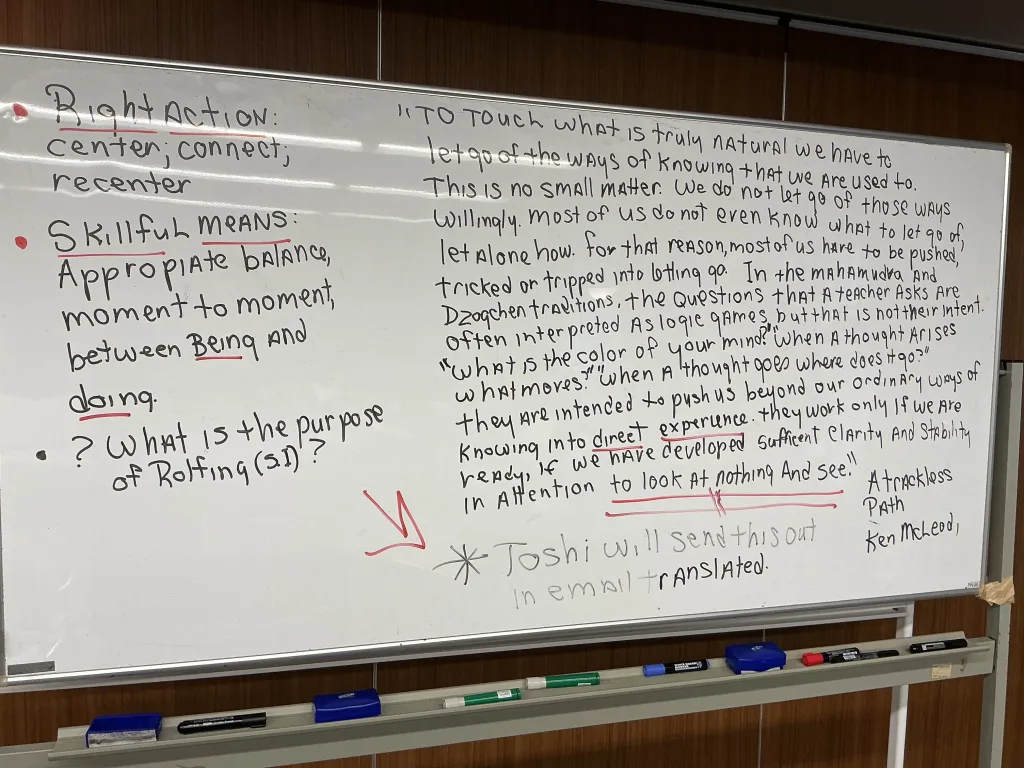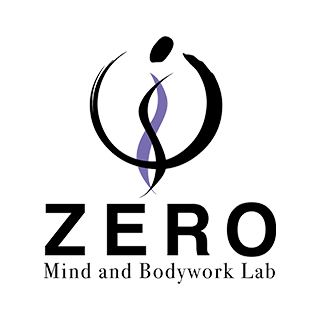Introduction
Hello, my name is Hidefumi Otsuka, and I offer Rolfing® sessions in Shibuya, Tokyo.
The three practice sessions with fellow students and external clients have successfully concluded, and today (July 11, 2025), we reached the final day of the Advanced Rolfing Training (taught by Ray McCall and Hiroyoshi Tahata). I am being certified as an Advanced Rolfer today.

In the final week of Phase 2 (July 8 and 10), the central themes were “Fundamental Vibration,” “Neutral Presence,” and “Closing Techniques and Perceptual Development.”
This article focuses on three key ideas that emerged from those two days of learning:
- What does neutrality mean in bodywork?
- How is a particular way of being cultivated?
- What exactly is Fundamental Vibration?
Ray’s examples drawn from Buddhist philosophy are often profound and sometimes use complex language. I’d like to share the phrases he used during training so readers can get a feel for how these concepts were taught and experienced.
What Is Fundamental Vibration?
In Phase 2, we explored a perceptual quality called Fundamental Vibration, which exists on a more existential level—different from structural or fascial approaches to touch.
Ray shared the following:
“Fundamental vibration is not about trying to find something absolute.
It’s something that arises out of the positioning, space, relationship, and contact.”
This view implies that we’re not trying to detect a specific vibration, but rather tuning into something that emerges uniquely within each moment of connection. Kawada-san also emphasized the importance of holding both the sense of attuning to the fundamental and the ongoing emergence of relationship in the moment.
🔍 What is Fundamental Vibration?
Fundamental Vibration refers to a kind of primordial resonance or vibrational ground of being. In musical terms, it would correspond to the fundamental tone—the base frequency before individual identity takes form. It’s like a subtle fluctuation or “trembling” that arises from the field itself, even before any musculoskeletal or visceral motion. It appears within space and relationship, and is sensed through refined perception.
You could say it begins not with “what I do” but with “how the world resonates through me.” In this way, Fundamental Vibration is less a definable frequency and more an existential resonance—a quality that appears in the now, within relationship.
Beyond “Looking” — From Look to See
To perceive such a “resonance,” we must shift our very mode of perception. Ray referenced a quote from Ken McLeod’s Trackless Path:
“What we’re developing is the ability to look at nothing and see.”

Ordinarily, we observe with the intent to “see something.” But to “see without looking” involves surrendering that intention and opening a receptive way of being. Rather than actively seeking, we allow what arises from the space to show itself. This is a practice of radical openness.
Right Action and Openness to Change
So what kind of way of being supports this state?
Ray used the phrase Right Action and explained it this way:
“Center, connect, recenter.
Moment to moment, appropriate balance between being and doing.”
Right Action does not imply a fixed or formulaic “correctness.” Rather, it refers to a dynamic state of openness—setting aside mental judgments and expectations to attune to what is truly needed right now.
It is not about being passive, nor is it about imposing action. Rather, it’s a balanced presence that listens delicately to the voice of the body and the relationship—without overreacting or suppressing. It requires a continuous return to neutrality and a fine-tuning of being and doing.
If a moment arises during a session where we feel, “This is enough,” then honoring that quiet realization by choosing notto intervene further can itself be a form of Right Action.
Ray said:
“If you really sense, ‘I think we’re done,’
ask your client: ‘Is there anything else you feel you need to be complete today?’”
This expresses a willingness to trust in organic closure. Rather than forcing action just because there’s time left in the session, we’re invited to honor the subtle sense that something may already be complete. Just like sensing Fundamental Vibration, this too is a way of listening to the body’s voice.
Letting the Body Reveal What It’s Ready to Show
In one practice session, a student shared how an old basketball injury surfaced once compensatory patterns were released. Ray offered this insight:
“There’s one theory that the client’s body knows the skills we have,
and it will present what we can help resolve.”
This suggests that the client’s body recognizes the practitioner’s available capacity and offers what is ready to be met. The more attuned the practitioner’s presence and neutrality, the more the body can safely reveal its “truth.” This emergence is precisely what Fundamental Vibration allows us to sense.
Vibration as a Bridge Between Being and Doing
By perceiving Fundamental Vibration, I experienced how our Doing (technique) naturally arises from our Being (presence). When rooted in Being, our Doing becomes spontaneously guided toward what is most appropriate.
Ray repeatedly emphasized:
“You can do any technique as a third paradigm holistic intervention,
or a second paradigm cause-and-effect act.”
What makes the difference is our presence—how we are. Fundamental Vibration becomes our “fundamental tone,” resonating into the space and into the relationship with the client.
Conclusion — The Quiet Trust in Transformation
To close, I’d like to share a quote from Pema Chödrön that Ray cited on the last day:
“We think that the point is to pass the test or solve the problem.
But the truth is that things don’t really get solved.
They come together and pull apart, then come together again.”
Neither sessions nor life are about “solving” anything. Things come together, fall apart, and reconnect. Neutrality is the posture that stays with that process. And Fundamental Vibration is the resonance that continues through it.
Where these two intersect—neutral presence and resonant being—I believe we find the true essence of healing and integration.

